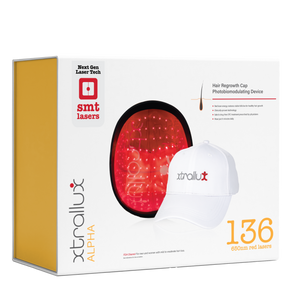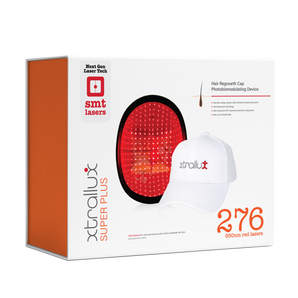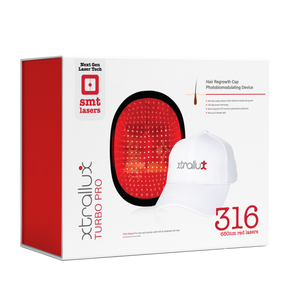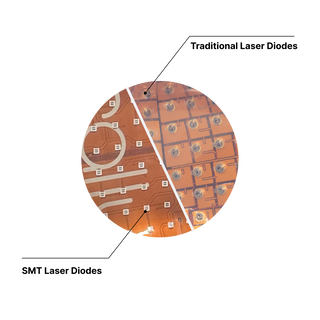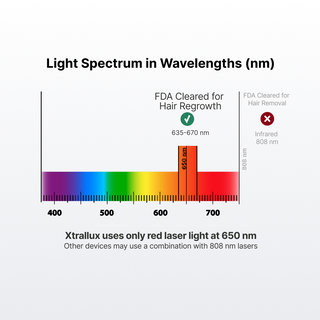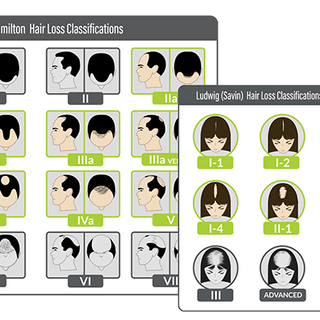Picture this: you're standing in your bathroom, staring at a small orange bottle. The label reads finasteride—a drug that promises to halt your hair loss. But tucked inside that innocent-looking package is a warning that might give you pause. Sexual dysfunction. Depression. Side effects that could persist even after you stop taking the pills. You're caught in an impossible choice: accept your receding hairline or risk consequences that could affect your quality of life for years to come.
What if I told you there's a third option—one that harnesses the same energy that powers life on Earth?
When Sunlight Meets Science
Every morning, billions of plants across the planet perform a quiet miracle. They capture photons from the sun and transform light into life. This process, photosynthesis, has sustained our world for billions of years. But here's what's fascinating: your hair follicles can perform their own version of this ancient dance with light.
Low-Level Laser Therapy, or LLLT, works on a principle that would make any botanist smile. Just as plants absorb specific wavelengths of light to fuel their growth, your hair follicles respond to carefully calibrated red light by awakening from their dormant state. The FDA approved this technology in 2007 after clinical studies demonstrated that specific wavelengths of red light—typically around 650-670 nanometers—can stimulate hair follicles and increase terminal hair counts.
The science behind this is elegant in its simplicity. LLLT targets cytochrome c oxidase in hair follicle mitochondria, boosting cellular respiration and producing more ATP—the energy currency that powers cell growth and repair. Think of it as giving your hair follicles a gentle energy drink, encouraging them to shift from their resting phase back into active growth.

The Drug Dilemma

Now, let's return to that orange bottle in your medicine cabinet. Finasteride and its brand-name cousin Propecia work by blocking an enzyme that converts testosterone to DHT, the hormone responsible for pattern hair loss. It's effective, sure—but at what cost?
Clinical studies report that up to 6% of men experience decreased libido, while erectile dysfunction affects a significant percentage of users. More troubling still, recent research has documented cases where these sexual side effects persist even after stopping the medication—a condition some call post-finasteride syndrome. In 2024, the UK's medicines regulator introduced special warning cards for finasteride, highlighting risks of depression, suicidal thoughts, and persistent sexual dysfunction.
The contrast is stark. While one treatment asks you to gamble with your body's natural chemistry, the other simply asks you to sit under some red light for six minutes a day.
Light Without Shadows
Here's where LLLT's safety record shines brightest: in over 15 years since FDA clearance, LLLT devices have reported no significant adverse effects beyond minor skin irritation. No sexual dysfunction. No mood changes. No persistent side effects lurking in your future.*
The therapy is almost ridiculously simple. You place a cap embedded with laser diodes on your head for six minutes daily—about the time it takes to make a cup of coffee. You can wear it while reading emails, during your morning commute, or while watching the news. The red light penetrates your scalp at precisely the wavelength your follicles crave, quietly encouraging them back to life.
Meta-analyses of randomized controlled trials consistently show that LLLT increases hair density compared to sham devices, with some studies reporting increases of 35-51% in hair counts. The results build gradually—nature's way rarely offers instant gratification—but they come without the anxiety of wondering what other parts of your body might pay the price.
Not All Light Is Created Equal
But here's where the story gets more nuanced. Just as not all plants photosynthesize with equal efficiency, not all laser devices deliver the same therapeutic punch. Many devices on the market mix true lasers with LEDs, diluting their power and precision. Others combine multiple wavelengths, creating a confused signal that your follicles struggle to interpret.
This is where Xtrallux stands apart from the crowd—and where understanding laser technology becomes crucial to your success.
The VCSEL Advantage
Xtrallux devices use something called VCSEL technology—Vertical Cavity Surface Emitting Lasers mounted using SMT (Surface Mount Technology). If that sounds technical, think of it this way: while most laser caps are like flashlights with inconsistent beams, VCSEL lasers are like precision surgical instruments.
VCSELs offer superior power stability, better heat control, and longer lifespans compared to traditional edge-emitting lasers. They exhibit minimal wavelength drift with temperature changes, ensuring your hair follicles receive consistent therapeutic light session after session. The SMT mounting process also provides better manufacturing control and higher yields, translating to more reliable devices.
Most importantly, Xtrallux uses only true lasers—no LEDs mixed in to confuse the signal. Every diode emits at the precise FDA-cleared wavelength proven effective for hair regrowth. We offer more lasers per dollar than any competitor, with models ranging from 136 diodes to 316, giving you maximum scalp coverage regardless of your budget.
A Choice Without Compromise
The beauty of LLLT lies not just in what it does, but in what it doesn't do. It doesn't ask you to alter your hormone levels or accept troubling side effects. It doesn't require you to choose between your hair and your peace of mind.
Instead, it offers something remarkably simple: the same energy that has powered life on Earth for billions of years, focused precisely where your hair follicles need it most. Six minutes a day. No side effects. No compromises.
In a world where so many medical treatments come with lengthy lists of warnings and side effects, LLLT stands as a reminder that sometimes the most effective solutions are also the gentlest ones. Your hair follicles have been waiting millions of years to dance with light again—perhaps it's time to let them.
References
- Low-Level Laser (Light) Therapy (LLLT) for Treatment of Hair Loss. PMC. https://pmc.ncbi.nlm.nih.gov/articles/PMC3944668/
- Role of Low-Level Light Therapy (LLLT) in Androgenetic Alopecia. PMC. https://pmc.ncbi.nlm.nih.gov/articles/PMC8906269/
- A Systematic Review and Meta-analysis of Randomized Controlled Trials of United States Food and Drug Administration-Approved, Home-use, Low-Level Light/Laser Therapy Devices for Pattern Hair Loss. PMC. https://pmc.ncbi.nlm.nih.gov/articles/PMC8675345/
- Finasteride and sexual side effects. PMC. https://pmc.ncbi.nlm.nih.gov/articles/PMC3481923/
- Persistent sexual side effects of finasteride for male pattern hair loss. PubMed. https://pubmed.ncbi.nlm.nih.gov/21418145/
- Finasteride: reminder of the risk of psychiatric side effects and of sexual side effects. GOV.UK. https://www.gov.uk/drug-safety-update/finasteride-reminder-of-the-risk-psychiatric-side-effects-and-of-sexual-side-effects-which-may-persist-after-discontinuation-of-treatment
- Men on finasteride are asked to stay vigilant for possible psychiatric and sexual side effects. GOV.UK. https://www.gov.uk/government/news/men-on-finasteride-asked-to-stay-vigilant-for-possible-psychiatric-and-sexual-side-effects
- Photobiomodulation Low-Level Laser Therapy. Atlanta Hair Surgeon. https://atlantahairsurgeon.com/non-surgical/photobiomodulation-low-level-laser-therapy-atlanta-ga/
- * See Indications for Use: https://xtrallux.com/pages/indications-for-use



